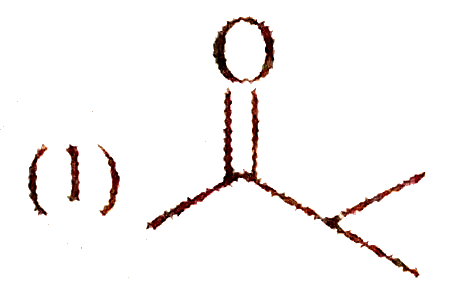Predict the product of the reaction CH3−CH3∣C∣H−H∣C∣Cl−CH2−CH=CH2alc.KOH−−−−−→
(CH3)2C=CH−CH2−CH=CH2
(CH3)2CH−CH=CH−CH=CH2
(CH3)2CH−CH=C∣CH3−CH=CH2
(CH3)2C=CH−C∣CH3=CH2
The correct Answer is:B
To predict the product of the reaction of the compound with alcoholic KOH, we will follow these steps:
Step 1: Identify the Starting Material
The starting material is a compound with the structure:
- CH₃-CH(CH₃)-C(Cl)-C(CH₂=CH₂)
This compound has a chlorine atom (Cl) attached to a carbon that is also connected to a carbon chain.
Step 2: Understand the Reaction Conditions
The reaction is conducted in the presence of alcoholic KOH. Alcoholic KOH acts as a strong base and can facilitate elimination reactions (dehydrohalogenation) by removing a hydrogen atom and a halogen atom (in this case, Cl).
Step 3: Identify the Acidic Hydrogen
In the presence of alcoholic KOH, the base will abstract an acidic hydrogen from the β-carbon (the carbon adjacent to the carbon with the Cl). In our structure, we have several hydrogens on the β-carbons.
Step 4: Possible Elimination Pathways
There are two possible pathways for elimination:
1. Pathway A: Remove a hydrogen from the carbon adjacent to the carbon with Cl, leading to the formation of a double bond.
2. Pathway B: Remove a hydrogen from the other β-carbon.
Step 5: Determine the Stability of the Resulting Alkenes
After the elimination, we will form alkenes:
- From Pathway A: This will yield a double bond between the two carbons adjacent to the carbon that originally had Cl.
- From Pathway B: This will yield a different alkene.
To predict the major product, we need to consider the stability of the resulting alkenes. Generally, more substituted alkenes are more stable due to hyperconjugation and the inductive effect.
Step 6: Predict the Major Product
After analyzing the possible products from both pathways, we find that the product from Pathway A is more stable due to higher substitution. The resulting alkene will have the structure:
- CH₃-CH(CH₃)-C=CH₂
Final Product
The final product of the reaction will be:
- CH₃-CH(CH₃)-C=CH₂
The starting material is a compound with the structure:
- CH₃-CH(CH₃)-C(Cl)-C(CH₂=CH₂)
The reaction is conducted in the presence of alcoholic KOH. Alcoholic KOH acts as a strong base and can facilitate elimination reactions (dehydrohalogenation) by removing a hydrogen atom and a halogen atom (in this case, Cl).
In the presence of alcoholic KOH, the base will abstract an acidic hydrogen from the β-carbon (the carbon adjacent to the carbon with the Cl). In our structure, we have several hydrogens on the β-carbons.
There are two possible pathways for elimination:
1. Pathway A: Remove a hydrogen from the carbon adjacent to the carbon with Cl, leading to the formation of a double bond.
2. Pathway B: Remove a hydrogen from the other β-carbon.
After the elimination, we will form alkenes:
- From Pathway A: This will yield a double bond between the two carbons adjacent to the carbon that originally had Cl.
- From Pathway B: This will yield a different alkene.
After analyzing the possible products from both pathways, we find that the product from Pathway A is more stable due to higher substitution. The resulting alkene will have the structure:
- CH₃-CH(CH₃)-C=CH₂
The final product of the reaction will be:
- CH₃-CH(CH₃)-C=CH₂
Topper's Solved these Questions
Similar Questions
Knowledge Check
IUPAC name of CH3−H∣C∣C2H5−C4H9∣C∣CH3−CH3 is
A2-Butyl-2-methyl-3-ethylbutaneB2-Ethyl-3, 3-dimethylheptaneC3, 4, 4-TrimethylheptaneD3, 4, 4-TrimethyloctaneCH3−CH3∣C∣OH−CH3∣C∣NH2−CH3HNO2−−−→Δ?
A B
B C
C D
D
Major product of the given reaction is
CH3−CH3∣C∣CH3−CH∣CI−CH3C2H5O−−−−−−→ACH3−CH3∣C∣CH3−CH∣OC2H5−CH3BCH3−CH3∣C∣CH3−CH=CH2CCH3−CH3∣C=C∣CH3−CH3DCH3−CH3∣C∣OC2H5−CH3∣CH−CH3
What is the major product alkene formed in the following elimination?
CH3CH2CH2CH3∣N+∣CH3−CH3∣C∣CH3−CH3Δ−−→
View SolutionCH3−CH3∣C∣CH3−CH=CH−CH3H−Cl−−−→ ?
View SolutionThe following reaction
CH3−H∣C∣CH3−CH3∣C∣X−CH3Alc.kOH−−−−−−−−−→−2O,−KBr
CH3−∣CH3(C)=CH3∣C−CH3
is an example of
View SolutionThe IUPAC name of CH3−CH3∣C∣CH3−CH=CH2
is -
View SolutionThe product of the given reaction ,
CH3−∣CH3∣C∣OH−CH3∣C∣NH2−CH3HNO2−−−→ Product is :
View Solution